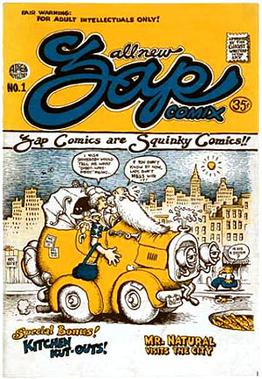
Underground comix are small press or self-published comic books that are often socially relevant or satirical in nature. They differ from mainstream comics in depicting content forbidden to mainstream publications by the Comics Code Authority, including explicit drug use, sexuality, and violence. They were most popular in the United States in the late 1960s and 1970s, and in the United Kingdom in the 1970s.
Manuel Rodriguez, better known as Spain or Spain Rodriguez, was an American underground cartoonist who created the character Trashman. His experiences on the road with the motorcycle club, the Road Vultures M.C., provided inspiration for his work, as did his left-wing politics. Strongly influenced by 1950s EC Comics illustrator Wally Wood, Spain pushed Wood's sharp, crisp black shadows and hard-edged black outlines into a more simplified, stylized direction. His work also extended the eroticism of Wood's female characters.
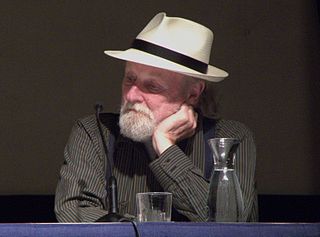
Gilbert Shelton is an American cartoonist and a key member of the underground comix movement. He is the creator of the iconic underground characters The Fabulous Furry Freak Brothers, Fat Freddy's Cat, and Wonder Wart-Hog.
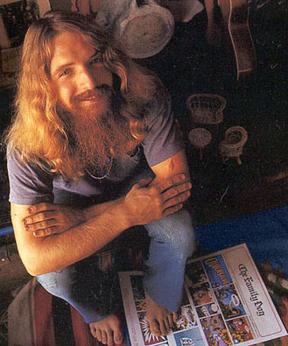
Richard Alden "Rick" Griffin was an American artist and one of the leading designers of psychedelic posters in the 1960s. He was a key figure in the underground comix movement as a fouding member of the Zap Comix collective. Griffin was closely identified with the Grateful Dead, designing some of their best-known posters and album covers including Aoxomoxoa. His work within the surfing subculture included both film posters and his comic strip, Murphy.

Last Gasp is a San Francisco–based book publisher with a lowbrow art and counterculture focus. Owned and operated by Ron Turner, for most of its existence Last Gasp was a publisher, distributor, and wholesaler of underground comix and books of all types.
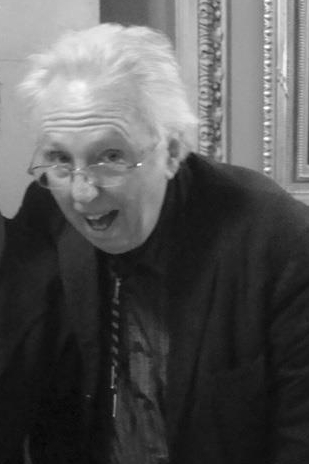
William Henry Jackson Griffith is an American cartoonist who signs his work Bill Griffith and Griffy. He is best known for his surreal daily comic strip Zippy. The catchphrase "Are we having fun yet?" is credited to Griffith.

Victor Moscoso is a Spanish–American artist best known for producing psychedelic rock posters, advertisements, and underground comix in San Francisco during the 1960s and 1970s. He was the first of the rock poster artists of the 1960s era with formal academic training and experience. He was the first of the rock poster artists to use photographic collage in many of his posters.
Paul Mavrides is an American artist, best known for his critique-laden comics, cartoons, paintings, graphics, performances and writings that encompass a disturbing yet humorous catalog of the social ills and shortcomings of human civilization. Mavrides worked with underground comix pioneer Gilbert Shelton on The Fabulous Furry Freak Brothers from 1978 to 1992. Mavrides has been noted for "adding new dimensions to the political comic" in the underground comix press of the 1970s and '80s.
Jack Edward Jackson, better known by his pen name Jaxon, was an American cartoonist, illustrator, historian, and writer. He co-founded Rip Off Press, and some consider him to be the first underground comix artist, due to his most well-known comic strip God Nose.
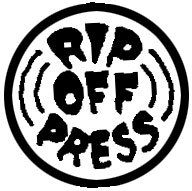
Rip Off Press Inc. is a comic book mail order retailer and distributor, better known as the former publisher of adult-themed series like The Fabulous Furry Freak Brothers and Rip Off Comix, as well as many other seminal publications from the underground comix era. Founded in 1969 in San Francisco by four friends from Austin, Texas — cartoonists Gilbert Shelton and Jack Jackson, and Fred Todd and Dave Moriaty — Rip Off Press is now run in Auburn, California, by Todd.
Rory Hayes was an American underground cartoonist in the late 1960s and early 1970s. His comics were drawn in an expressionistic, primitivist style and usually dealt with grim subject matter such as paranoia, violent crime, and drug abuse. In addition to his own titles, Bogeyman and Cunt Comics, he was published in many of the most prominent comics in the underground scene, including Bijou Funnies and Arcade.
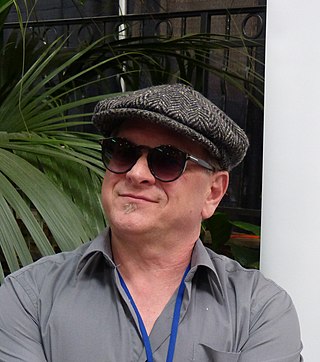
Mark Bodē ( born February 18, 1963) is an American cartoonist. The son of underground comics legend Vaughn Bodē, Mark shares the Bodē family style and perpetuates many of his late father's creations as well as his own works. He is best known for his work on Cobalt-60, Miami Mice, and The Lizard of Oz. Bodē has also worked for Heavy Metal magazine and on The Teenage Mutant Ninja Turtles.
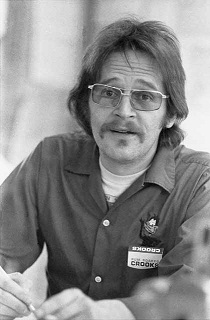
Dave Sheridan was an American cartoonist and underground comix artist. He was the creator of Dealer McDope and collaborated with Gilbert Shelton and Paul Mavrides on The Fabulous Furry Freak Brothers. As creative partner with fellow underground creator Fred Schrier, using the name "Overland Vegetable Stagecoach," they worked on Mother's Oats Funnies, published by Rip Off Press from 1970 to 1976.

Diane Robin Noomin was an American comics artist associated with the underground comics movement. She is best known for her character DiDi Glitz, who addresses transgressive social issues such as feminism, female masturbation, body image, and miscarriages.
Larry Fuller is an African-American underground comix writer, publisher, and promoter. Along with other such notables as Richard "Grass" Green, Guy Colwell, and Fuller's long-time business partner and friend, Raye Horne, Fuller made sure that the voices of black comic book creators were heard in a time when their artistic efforts were largely ignored. On the topics of race and sexuality, Fuller mastered the art of delivering social commentary in humorous form.
Larry S. Todd is an American illustrator and cartoonist, best known for Dr. Atomic and his other work in underground comix, often with a science fiction bent.
Theodore Richards was an American web designer and cartoonist, best known for his underground comix.
Willy Murphy was an American underground cartoonist. Murphy's humor focused on hippies and the counterculture. His signature character was Arnold Peck the Human Wreck, "a mid-30s beanpole with wry observations about his own life and the community around him." Murphy's solo title was called Flamed-Out Funnies; in addition, he contributed to such seminal underground anthologies as Arcade, Bijou Funnies, and San Francisco Comic Book, as well as the National Lampoon.
Michele Wrightson, also known as Michele Brand, was an American artist who worked in the comic book industry. The former wife of underground cartoonist Roger Brand, she started out as an underground comix cartoonist. Later, when she was married to comics artist Bernie Wrightson, she made her name as a colorist. She was a key contributor to the first all-female underground comic, It Ain't Me, Babe, as well as its follow-up series, Wimmen's Comix.
Harry Driggs was an American artist, graphic designer, political activist, and underground cartoonist. Much of his comix work was published under the name R. Diggs. Driggs was a longtime resident of San Francisco, where he worked in advertising as a graphic designer and art director.










